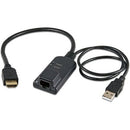Description
Designed to streamline secure server access in data centers, the Vertiv Avocent MPU Virtual Media CAC HDMI USB Keyboard-Mouse bundle delivers a compact, high-performance interface for MergePoint Unity KVM environments. This versatile access cable supports HDMI video, virtual media, and Common Access Card (CAC) authentication, all while providing reliable USB keyboard and mouse connectivity. Built for easy integration with Vertiv Avocent MergePoint Unity switches, it simplifies remote management, reduces downtime, and enhances operational security by enabling credentialed access directly from a single console. If you manage multiple servers or racks, this MPU cable helps you consolidate control, improve response times, and maintain tight security standards without compromising on speed or reliability.
- HDMI video interface for clear, reliable display — This access cable delivers high-quality HDMI video to your server console or display, ensuring crisp visuals and responsive control during routine maintenance, firmware updates, or remote troubleshooting. Suitable for modern data center displays and KVM workflows, it minimizes latency and preserves color accuracy for faster, more accurate server management.
- Virtual Media support to mount remote media — Unlock the ability to mount virtual media from a central console, enabling remote software installations, firmware updates, and diagnostic tools without physically visiting each server. Virtual media capability accelerates provisioning, testing, and recovery tasks across multiple hosts, reducing mean time to repair (MTTR) and improving maintenance efficiency.
- CAC authentication for heightened security — The MPU interface embraces CAC-based access, offering credentialed login and strong authentication workflows. This is essential for regulated environments where personnel must verify credentials before gaining access to critical servers. CAC support helps organizations meet compliance requirements while maintaining seamless operator workflows.
- USB 2.0 keyboard and mouse connectivity — Integrated USB 2.0 ports ensure reliable input device support, enabling smooth navigation and precise control during sessions. Whether you’re performing routine administration or complex configuration tasks, the USB keyboard and mouse connections provide consistent, plug-and-play usability with a wide range of peripherals.
- RJ-45 management port for flexible connectivity — An RJ-45 management interface facilitates straightforward integration into your network or on-site management topology. This port supports secure management traffic and enables out-of-band control, ensuring you can reach and control your server infrastructure even during network outages or maintenance windows.
Technical Details of Vertiv Avocent MPU Virtual Media CAC HDMI USB Keyboard-Mouse
- Video interface: HDMI
- USB interface: USB 2.0
- Virtual media: Supported — remote mounting of media for installations, updates, and diagnostics
- CAC support: Supported — compatible with credential-based access workflows
- Ports: RJ-45 female port, USB 2.0 port for keyboard/mouse
- Compatibility: Designed for Vertiv Avocent MergePoint Unity KVM switches and related server access ecosystems
- Form factor: Access cable designed for secure, consolidated console connections
- Power requirements: Passive interface cable (no separate power supply required for operation)
How to install Vertiv Avocent MPU Virtual Media CAC HDMI USB Keyboard-Mouse
- Power down the target equipment and the MergePoint Unity KVM switch according to your data-center protocols before connecting peripherals.
- Connect the HDMI video output from the MPU to the corresponding HDMI input on the server console or display device. Ensure the HDMI cable is securely seated at both ends for reliable video transmission.
- Attach the USB keyboard and mouse to the USB 2.0 ports on the MPU. Verify that the connected input devices are recognized by the local console and firmware during the initial session.
- If CAC authentication is required in your environment, ensure your CAC-enabled workflow is configured. Insert the CAC card and follow your organization’s login process to enable credentialed access from the console.
- Connect the RJ-45 management port to your network or management switch, following your IT security guidelines. This enables management traffic and, if supported, out-of-band control for remote sessions.
- Power on the server(s) and the MergePoint Unity KVM switch. Open the management interface and initiate a console session. Test virtual media mounting, CAC-authenticated login, and USB device detection to confirm full functionality.
Frequently asked questions
-
What is the Vertiv Avocent MPU Virtual Media CAC HDMI USB Keyboard-Mouse?
The MPU interface is a dedicated access cable designed for Vertiv Avocent MergePoint Unity KVM switches. It provides HDMI video, virtual media, CAC authentication, and USB keyboard/mouse connectivity in a single, streamlined package, simplifying secure server management across multiple hosts.
-
Does it support virtual media and CAC authentication simultaneously?
Yes. The design supports virtual media mounting alongside CAC-based access, enabling secure credentialed sessions with remote media capabilities for efficient installation and maintenance tasks.
-
Which video and input devices are compatible?
The cable uses an HDMI video interface and USB 2.0 for keyboard and mouse, offering broad compatibility with modern displays and a wide range of input peripherals commonly used in data centers.
-
Is this cable compatible with all Vertiv Avocent MergePoint Unity configurations?
It is designed to work with Vertiv Avocent MergePoint Unity KVM switches and related components. For best results, verify compatibility with your exact switch model and firmware version in your product documentation or support resources.
-
What are typical deployment benefits?
Key benefits include consolidated console management for multiple servers, secure CAC-based access, remote media capabilities to accelerate software deployments and updates, and reliable USB input support. The result is reduced travel time to data centers, faster maintenance cycles, and improved security posture.
Customer reviews
Showing - Of Reviews


